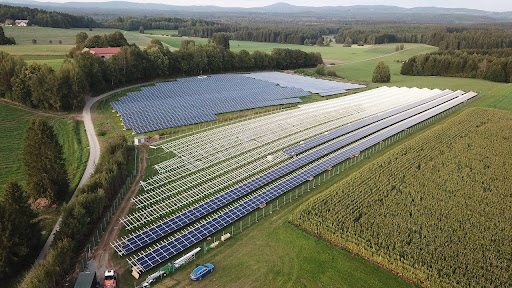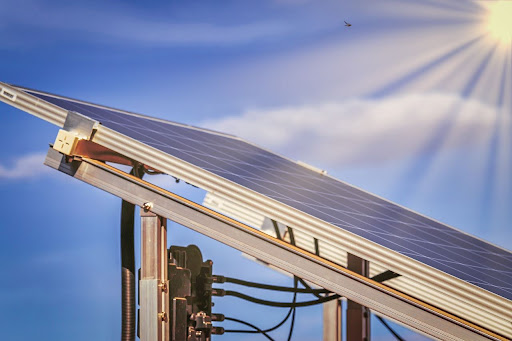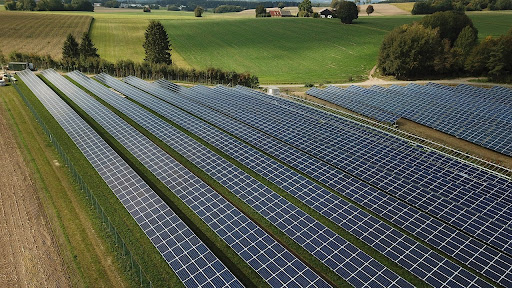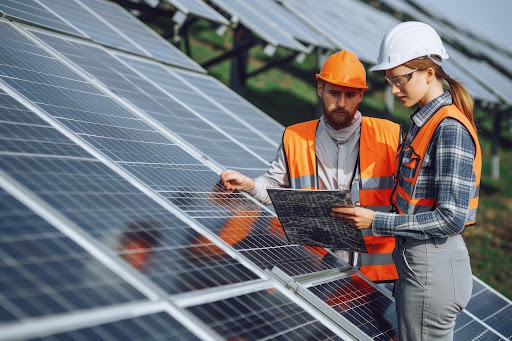Key Takeaways
- Initial installation costs for solar panels range from $15,000 to $30,000 for an average farm.
- Government incentives can cover up to 30% of solar installation costs.
- Solar panels can be used for powering irrigation systems, livestock operations, and farm buildings.
- High initial investment and land use conflicts can deter farmers from adopting solar energy solutions.
- Nuance Energy’s Osprey PowerRACK® is a good option for farms and agriculture, with its quick, low-impact solar racking system that adapts to any terrain without disrupting the land or crops.
| Nuance Energy is your superior solution for Ground Mount solar. Our patented foundation technology Osprey PowerRACK® allows for rapid installation using only handheld tools, significantly reducing both time and costs compared to traditional racking systems. This cutting-edge technology works for residential and commercial installations, and Nuance Energy empowers solar installers to take back control of their installation schedules, control project COGS, gain market share, increase the speed of installation, and reduce the cost of labor. In contrast, a traditional ground mount is much more unpredictable, slower, and costly.
Find out how Nuance Energy can accelerate your solar projects with the Osprey PowerRACK® line, and boost your profitability. Contact us today to discuss our innovative ground-mount solutions. |

The integration of solar power presents an exciting opportunity for enhancing sustainability on farms
Solar Power Options for Farms
Solar energy presents a transformative opportunity for farms, offering sustainable solutions to reduce costs and enhance productivity. Farmers can now lower energy expenses, improve water management, and increase crop yields.
Common Solar Applications in Farming
By using solar panels to power water pumps, farmers can ensure a steady water supply without relying on grid electricity. This is especially beneficial in remote areas where power lines may not be readily available.
In addition, solar energy can be used to power livestock operations. For example, solar panels can provide electricity for ventilation systems, milking machines, and feeding equipment. This reduces energy costs and also ensures a consistent power supply, which is crucial for maintaining animal welfare.
Comparison of Solar Technologies
The most common types of solar technologies available for farms include photovoltaic (PV) panels, solar thermal systems, and solar water pumps.
Photovoltaic panels are the most widely used solar technology. They convert sunlight directly into electricity and can be installed on rooftops or ground-mounted systems. PV panels are known for their efficiency and durability, making them a popular choice for farms.
On the other hand, solar thermal systems use sunlight to heat water or air, which can then be used for various farm operations. They’re particularly effective for heating greenhouses or providing hot water for livestock facilities.
Lastly, solar water pumps are specifically designed for irrigation purposes. They use solar energy to pump water from wells, rivers, or reservoirs, providing a sustainable and cost-effective solution for water management on farms.

Solar power can significantly lower energy costs, allowing farmers to allocate resources to other critical areas.
Evaluating the Cost of Solar Energy
The initial investment for solar energy systems includes the cost of solar panels, inverters, mounting equipment, and installation labor. While this may seem daunting, you should consider the long-term savings and return on investment. In many cases, solar systems can pay for themselves within 5 to 10 years, depending on energy consumption and available incentives.
Solar Energy Advantages for Farmers
Reduction in Operating Costs
Solar energy can dramatically reduce the operating costs of a farm. By generating electricity on-site, farmers can cut down on their reliance on the grid and avoid the volatility of energy prices. This can lead to savings of up to 70% on annual energy costs, freeing up capital for other critical investments.
Energy Independence and Reliability
Solar power offers farmers a level of energy independence that is unmatched by traditional energy sources. By producing their electricity, farmers are less susceptible to power outages and fluctuations in energy prices. This reliability is crucial for maintaining consistent farm operations, particularly in remote areas where access to the grid may be limited.
Solar energy systems can also be paired with battery storage solutions, allowing farmers to store excess energy generated during the day for use at night or during cloudy periods. This ensures a continuous power supply, enhancing the resilience of farm operations.
Environmental Impact and Sustainability
Switching to solar energy is both economically beneficial and environmentally responsible. Solar power is a clean and renewable energy source that significantly reduces greenhouse gas emissions compared to fossil fuels. By adopting solar, farmers can reduce their carbon footprint and contribute to a more sustainable future.
Solar energy systems also have a long lifespan, typically lasting 25 to 30 years, making them a durable and sustainable choice for powering agricultural operations.

From running irrigation pumps to lighting barns and powering electric fences, solar energy is adaptable to a wide range of agricultural applications.
Pitfalls and Challenges of Solar in Agriculture
Upfront Costs and Financial Considerations
The cost of solar panels, inverters, and installation can add up quickly. Although government incentives and grants can alleviate some of these expenses, farmers must still be prepared for a substantial initial outlay. Careful financial planning and consideration of available financing options are crucial steps in the decision-making process.
Alternatively, farmers can also opt for more affordable systems that require minimal installation costs like Nuance Energy’s Osprey PowerRACK®. The system’s quick installation, using simple hand tools significantly lowers labor expenses. Additionally, its modular design minimizes mobilization and equipment costs, making it a budget-friendly option for large and small projects alike.
“Our Earth Anchor System allows for nimble, fast deployment, making it easy for installers to scale up quickly and tackle multiple projects without being constrained by the need for heavy machinery.” — Tommy Boguess
Besides that, farmers should evaluate the potential return on investment and payback period for solar systems. While most systems offer a return within 5 to 10 years, this can vary based on energy consumption, location, and available incentives.
Land Usage and Space Requirements
Installing solar panels requires adequate space, which can be a concern for farms with limited land availability. Ground-mounted solar systems can take up significant space, potentially impacting crop production or livestock grazing areas. Therefore, it’s essential to assess the land usage implications and look at options such as rooftop installations to optimize space utilization.
Farmers should also consider the orientation and tilt of solar panels to maximize energy production. This may involve strategic planning and consultation with solar experts to ensure optimal placement and efficiency.
Intermittency and Energy Storage Solutions
Solar energy production is inherently intermittent, as it depends on sunlight availability. This can pose challenges for farms that require a constant power supply. However, advances in battery storage technology offer solutions for managing intermittency.
By incorporating battery storage systems, farmers can store excess solar energy generated during peak sunlight hours and use it during periods of low production. This enhances the reliability of solar power and ensures a steady energy supply for farm operations.
|
Pros |
Cons |
|
Low operational costs |
High initial investment |
|
Energy independence |
Requires backup equipment |
|
Environmental sustainability |
Takes up valuable land |
|
Reliable power source |
Emergency repairs can be difficult |
|
Low maintenance |
Aesthetic concerns |
|
Enhances crop yields |
Limited compatibility with crops |
|
Government incentives |
Financial barriers for some farms |
|
Diversifies income streams |
Long-term commitment to installation |
Implementing Solar Solutions on Farms
Installation Process and Considerations
The installation process for solar systems involves several steps, beginning with a site assessment to determine the best location for the panels. Factors such as sunlight exposure, shading, and available space are considered during this assessment. Once the optimal location is identified, the installation team will proceed with mounting the panels and connecting them to the electrical system.
It helps to work with experienced solar installers who understand the unique challenges of agricultural settings – they can provide valuable insights into optimizing the installation for maximum efficiency and performance.
Also consider that while systems like Nuance Energy’s Osprey PowerRACK® use real-time pull testing right on-site and do not require detailed soil analysis or geotechnical reports, not all systems offer this advantage. In the case of the latter, make sure that all necessary permits and approvals are obtained before commencing the installation process.
Maintenance and Operational Upkeep
Maintaining your solar energy system is essential for ensuring its longevity and efficiency. Fortunately, solar panels require minimal maintenance, primarily involving regular cleaning to remove dust and debris that may obstruct sunlight. It’s also important to periodically inspect the panels and electrical connections for any signs of damage or wear.

Engaging a professional maintenance service can help keep your solar system in optimal condition, ensuring consistent energy production and extending the lifespan of the equipment.
Expert Recommendations for Decision-Making
Consulting with Energy Advisors
Energy advisors conduct energy audits to assess your current energy consumption and identify areas where solar power can make the most significant impact. Additionally, advisors can help you learn more about available incentives and financing options to make solar energy more accessible and affordable.
Evaluating Farm’s Specific Energy Needs
Consider the various applications you intend to power with solar energy, such as irrigation, livestock operations, or farm buildings. Analyze your current energy consumption patterns and identify peak usage periods to determine the capacity and configuration of the solar system.
Additionally, consider future energy needs and potential expansions to ensure that the solar system can accommodate growth and changes in your farm’s operations. By thoroughly evaluating your energy requirements, you can make informed decisions that maximize the benefits of solar power.
Also think of the potential for integrating energy storage solutions, such as batteries, to enhance the reliability and flexibility of your solar system. This can provide backup power during periods of low sunlight and ensure a consistent energy supply for critical farm operations.
Connecting with Professional Installers
Experienced installers can provide expert advice on system design, equipment selection, and installation best practices. They can also handle the necessary permits and approvals, streamlining the process and ensuring compliance with local regulations.
When selecting an installer, consider their experience in agricultural settings and their track record of successful installations. Request references and reviews from previous clients to gauge their reliability and expertise. By partnering with reputable installers, you can achieve a seamless transition to solar energy and maximize the benefits for your farm.
Why is Nuance Energy’s Osprey PowerRACK® a Good Solar Alternative for Farms?
- Quick Installation: Nuancer Energy’s Osprey PowerRACK® can be set up in a single day, allowing farms to harness solar energy without lengthy delays, helping to maintain their productivity.
- Adaptability to Terrain: This system easily accommodates various soil types and conditions, making it suitable for farms with challenging landscapes, whether rocky, sandy, or frozen.
- Cost-Effective: By eliminating the need for heavy machinery and specialized labor, it helps reduce installation costs, making solar energy more accessible for farm operations.
- Minimal Environmental Impact: The concrete-free design preserves the natural landscape, which is important for farms aiming to maintain soil health and ecosystem balance.
- Year-Round Functionality: The system can be installed in all seasons, ensuring that farms can take advantage of solar energy generation regardless of weather conditions.
Looking to make a sustainable choice for your farm?
Talk to our team and get a quote for your upcoming project.
Frequently Asked Questions
What are the main benefits of solar energy for farms?
Solar energy offers significant benefits for farms, including reduced reliance on fossil fuels, which lowers greenhouse gas emissions and helps combat climate change. Additionally, it decreases long-term operational costs by providing a sustainable energy source for irrigation and machinery, ultimately enhancing farm profitability. Plus, solar installations can improve crop yields by creating favorable microclimates, protecting crops from extreme weather, and allowing for more efficient water usage.
Are there any government incentives available for solar installations?
Government programs, such as the Federal Investment Tax Credit (ITC), can cover up to 30% of the installation costs, making solar energy more affordable for farmers. Additionally, state and local incentives may provide further financial support, reducing the overall investment required.
How much does it cost to install solar panels on a farm?
The cost of installing solar panels on a farm depends on several factors, including the size of the system, location, and installation requirements. On average, the cost ranges from $15,000 to $30,000, but this can be reduced through available incentives and grants.
What are some cost-effective solar options for farms?
Ground-mounted systems like Nuance Energy’s Osprey PowerRACK® are a scalable, affordable solution for farms. These systems are designed to be installed quickly and easily without the need for heavy machinery or concrete, cutting down on both labor costs and installation time. Their adaptability to various soil types makes them ideal for agricultural settings where terrain can be unpredictable.
Save Time & Money on Your Next Solar Project
Request a QuoteRECENT POSTS
- DPW Solar vs Nuance Energy Mounted Solar Options: Cost & Benefits
- Geotechnical Report Cost & Requirements For Solar Projects
- Are Solar Panels Worth It In Nevada? Costs & Options
- OSPREY PowerRack Ground Mount System Compatibility: Single- and Dual-Axis Trackers
- Rammed Earth Foundation For Solar Arrays: Cost, Pros & Cons
- Agrivoltaics Explained: Solar & Agriculture Combined
- Large Scale Solar Systems Options: Pros & Cons
- Best Solar Options For Farms & Agriculture: Cost, Pros & Cons
- Unirac vs MT Solar Mounted Options: Cost & Benefits
- IronRidge vs Grengy Mounted Solar Options: Cost & Benefits

